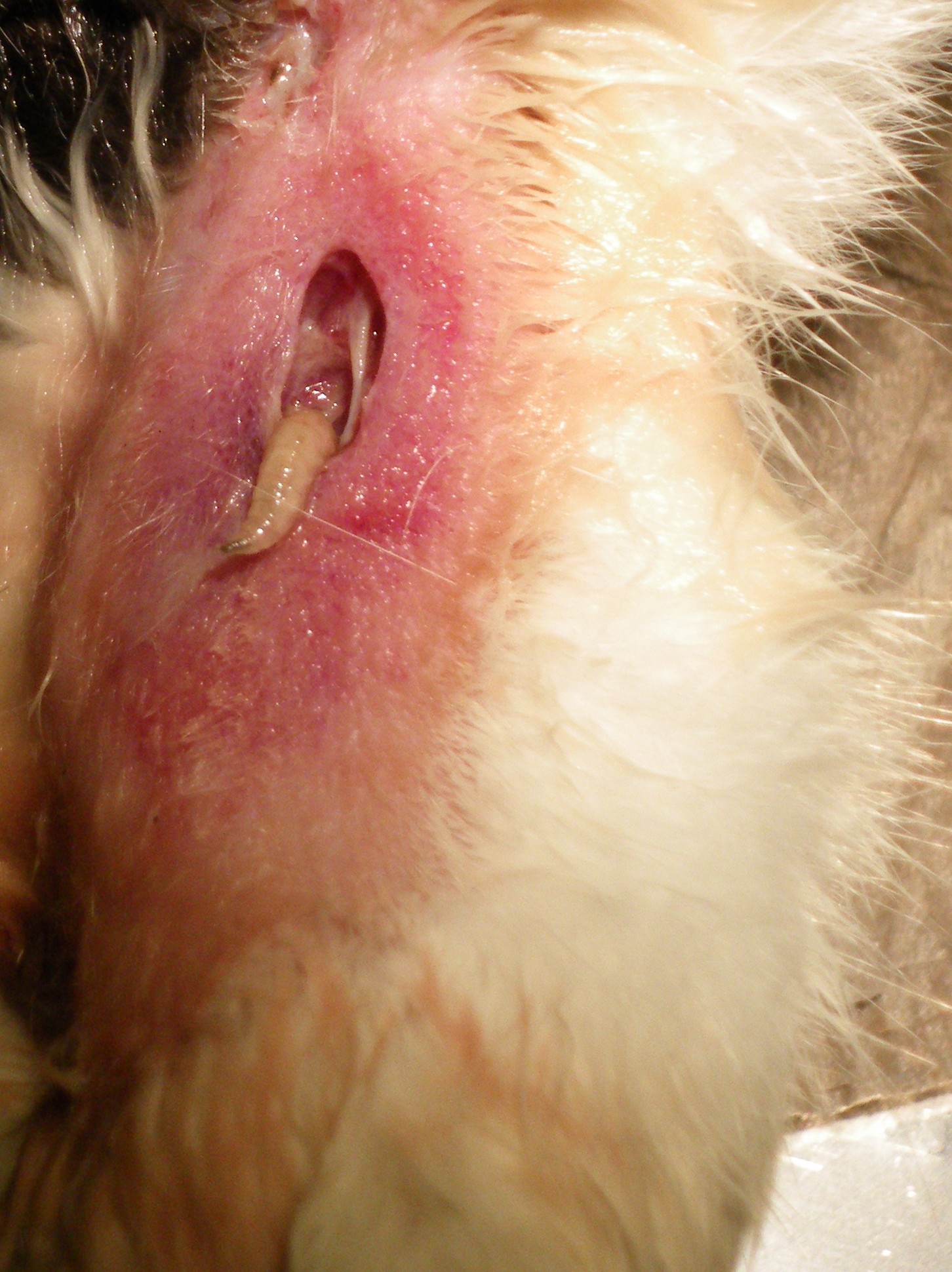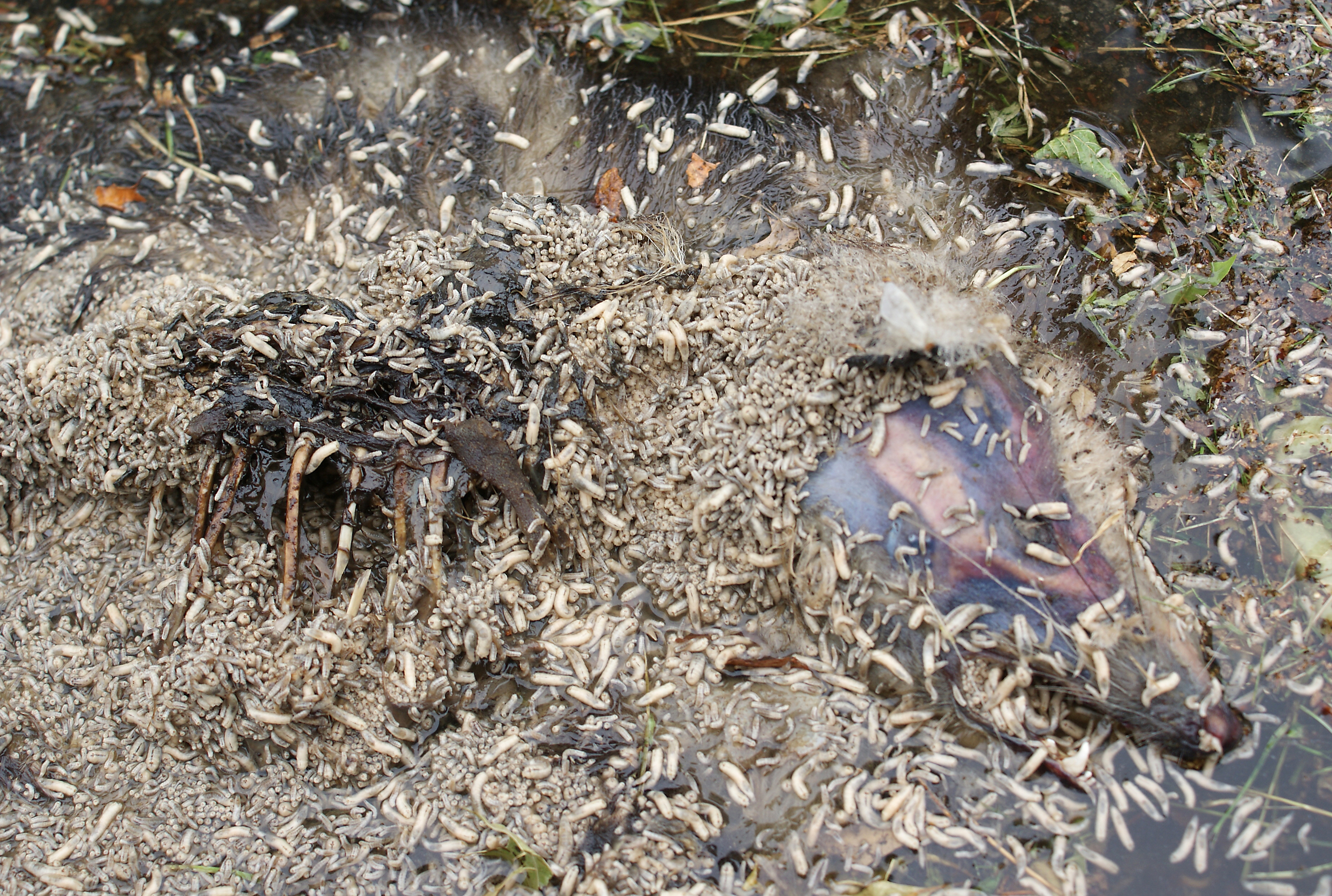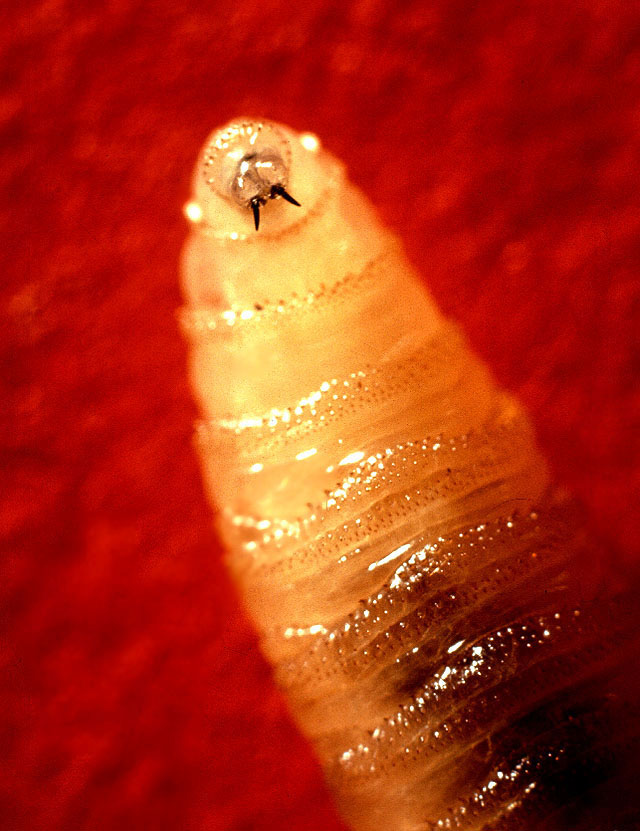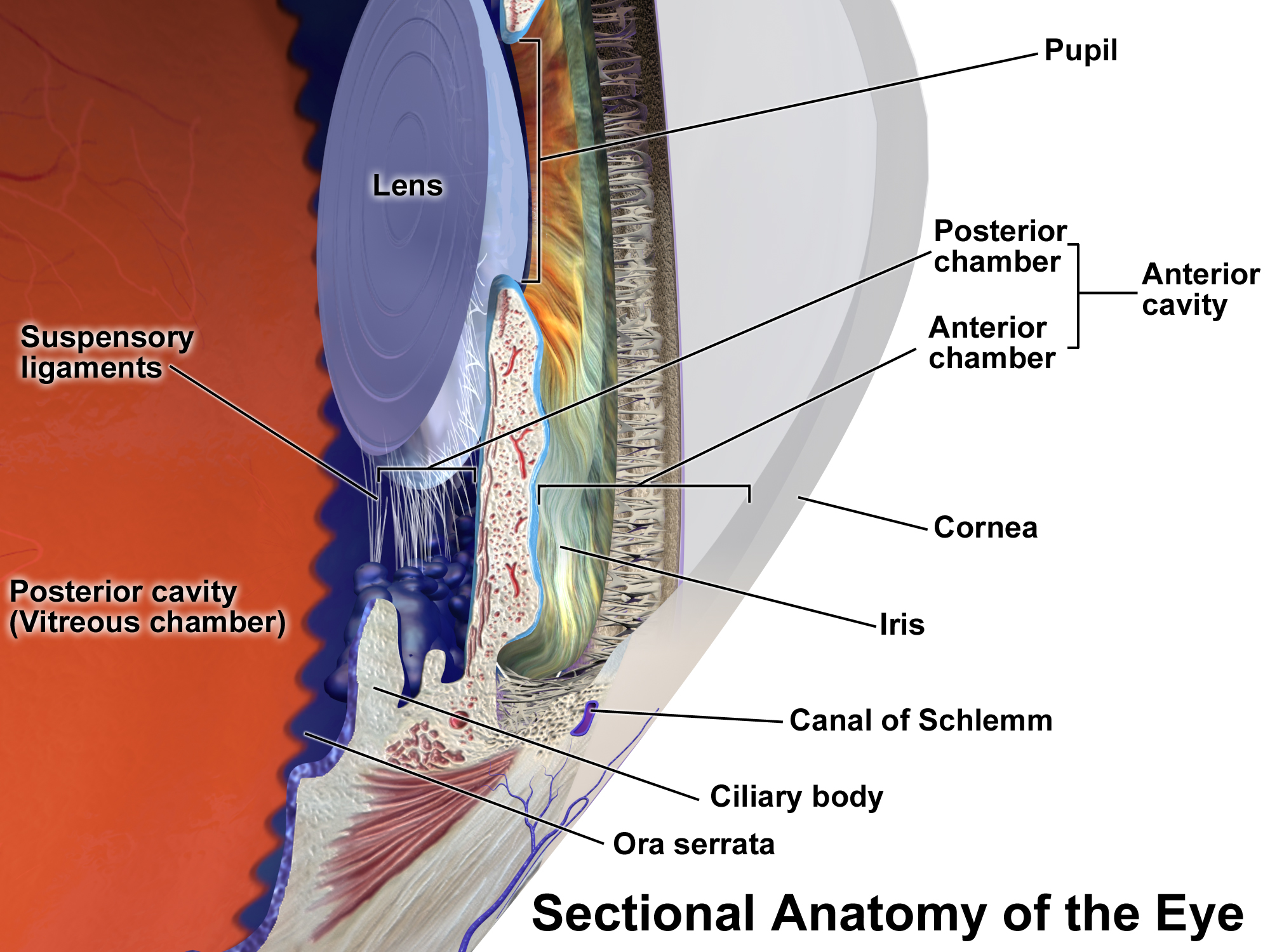|
Myiasis
Myiasis is the parasitic infestation of the body of a live animal by fly larvae (maggots) which grow inside the host while feeding on its tissue. Although flies are most commonly attracted to open wounds and urine- or feces-soaked fur, some species (including the most common myiatic flies—the botfly, blowfly, and screwfly) can create an infestation even on unbroken skin and have been known to use moist soil and non-myiatic flies (such as the common housefly) as vector agents for their parasitic larvae. Because some animals (particularly non-native domestic animals) cannot react as effectively as humans to the causes and effects of myiasis, such infestations present a severe and continuing problem for livestock industries worldwide, causing severe economic losses where they are not mitigated by human action. Although typically a far greater issue for animals, myiasis is also a relatively frequent disease for humans in rural tropical regions where myiatic flies thrive, and of ... [...More Info...] [...Related Items...] OR: [Wikipedia] [Google] [Baidu] |
Calliphoridae
The Calliphoridae (commonly known as blow flies, blow-flies, carrion flies, bluebottles, greenbottles, or cluster flies) are a family of insects in the order Diptera, with almost 1,900 known species. The maggot larvae, often used as fishing bait, are known as gentles. The family is known to be polyphyletic, but much remains disputed regarding proper treatment of the constituent taxa, some of which are occasionally accorded family status (e.g., Bengaliidae and Helicoboscidae). The name blowfly comes from an older English term for meat that had eggs laid on it, which was said to be flyblown. The first known association of the term "blow" with flies appears in the plays of William Shakespeare: '' Love's Labour's Lost'', '' The Tempest'', and '' Antony and Cleopatra''. Description Characteristics Calliphoridae adults are commonly shiny with metallic colouring, often with blue, green, or black thoraces and abdomens. Antennae are three-segmented and aristate. The aristae are pl ... [...More Info...] [...Related Items...] OR: [Wikipedia] [Google] [Baidu] |
Eristalis Tenax
''Eristalis tenax'', the common drone fly, is a common, migratory, cosmopolitan species of hover fly. It is the most widely distributed syrphid species in the world, and is known from all regions except the Antarctic. It has been introduced into North America and is widely established. It can be found in gardens and fields in Europe and Australia. It has also been found in the Himalayas. Distribution The larval form of the drone-fly, the rat-tailed maggot, is found on every continent except Antarctica, and ranges to the highest latitudes in the North. This species is not prevalent in extremely southern latitudes, neither is it common in arid areas of Europe, Asia, and Africa. In the United States, this species is found as far north as Alaska and as far south as California and Florida. Description ''Eristalis tenax'' is a large, stocky bee mimic. The eyes are marbled in black. Males have hovering displays. The average wing length is 9.75–13 mm and their average wingspa ... [...More Info...] [...Related Items...] OR: [Wikipedia] [Google] [Baidu] |
Maggot
A maggot is the larva of a fly (order Diptera); it is applied in particular to the larvae of Brachycera flies, such as houseflies, cheese flies, and blowflies, rather than larvae of the Nematocera, such as mosquitoes and crane flies. Entomology "Maggot" is not a technical term and should not be taken as such; in many standard textbooks of entomology, it does not appear in the index at all. In many non-technical texts, the term is used for insect larvae in general. Other sources have coined their own definitions; for example: "The term applies to a grub when all trace of limbs has disappeared" and "Applied to the footless larvae of Diptera".Smith, John. BExplanation of terms used in entomology Brooklyn Entomological Society, 1906. Additionally, in ''Flies: The Natural History and Diversity of Diptera'', the author claims maggots "are larvae of higher Brachycera ( Cyclorrhapha)." Maggot-like fly larvae are of significance in ecology and medicine; among other roles, var ... [...More Info...] [...Related Items...] OR: [Wikipedia] [Google] [Baidu] |
Botfly
Botflies, also known as warble flies, heel flies, and gadflies, are a family of flies known as the Oestridae. Their larvae are internal parasites of mammals, some species growing in the host's flesh and others within the gut. ''Dermatobia hominis'' is the only species of botfly known to parasitize humans routinely, though other species of flies cause myiasis in humans. General A botfly, also written bot fly, bott fly or bot-fly in various combinations, is any fly in the family Oestridae. Their life cycles vary greatly according to species, but the larvae of all species are internal parasites of mammals. Largely according to species, they also are known variously as warble flies, heel flies, and gadflies. The larvae of some species grow in the flesh of their hosts, while others grow within the hosts' alimentary tracts. The word "bot" in this sense means a maggot. A warble is a skin lump or callus such as might be caused by an ill-fitting harness, or by the presence of a warble ... [...More Info...] [...Related Items...] OR: [Wikipedia] [Google] [Baidu] |
Hypoderma Tarandi
''Hypoderma tarandi'', also known as the reindeer warble fly and reindeer botfly, is a species of warble fly that is parasitic on reindeer. The larvae of this fly are a skin-penetrating ectoparasite that usually infest populations of reindeer and caribou in Arctic areas, causing harm to the hides, meat and milk in domesticated herds. They also may cause ophthalmomyiasis in humans, leading to uveitis, glaucoma and retinal detachment. ''H. lineatum'' and ''H. sinense'' may also infest humans. As food In cold climates supporting reindeer- or caribou-reliant populations, large quantities of ''Hypoderma tarandi'' maggots are available to human populations during the butchery of animals. ''Hypoderma tarandi'' larvae were part of the traditional diet of the Nunamiut people. Copious art dating back to the Pleistocene in Europe confirms their consumption in premodern times, as well. The sixth episode of season one of the television series '' Beyond Survival'' entitled "The Inuit - ... [...More Info...] [...Related Items...] OR: [Wikipedia] [Google] [Baidu] |
Cochliomyia Hominivorax
''Cochliomyia hominivorax'', the New World screw-worm fly, or screw-worm for short, is a species of parasitic fly that is well known for the way in which its larvae (maggots) eat the living tissue of warm-blooded animals. It is present in the New World tropics. There are five species of '' Cochliomyia'' but only one species of screw-worm fly in the genus is parasitic; there is also a single Old World species in a different genus (''Chrysomya bezziana''). Infestation of a live vertebrate animal by a maggot is technically called myiasis. While the maggots of many fly species eat dead flesh, and may occasionally infest an old and putrid wound, screw-worm maggots are unusual because they attack healthy tissue. Life cycle Screw-worm females lay 250–500 eggs in the exposed flesh of warm-blooded animals, including humans, such as in wounds and the navels of newborn animals. The larvae hatch and burrow into the surrounding tissue as they feed. Should the wound be disturbed during th ... [...More Info...] [...Related Items...] OR: [Wikipedia] [Google] [Baidu] |
Uveitis
Uveitis () is inflammation of the uvea, the pigmented layer of the eye between the inner retina and the outer fibrous layer composed of the sclera and cornea. The uvea consists of the middle layer of pigmented vascular structures of the eye and includes the iris, ciliary body, and choroid. Uveitis is described anatomically, by the part of the eye affected, as anterior, intermediate or posterior, or panuveitic if all parts are involved. Anterior uveitis ( iridocyclytis) is the most common, with the incidence of uveitis overall affecting approximately 1:4500, most commonly those between the ages of 20-60. Symptoms include eye pain, eye redness, floaters and blurred vision, and ophthalmic examination may show dilated ciliary blood vessels and the presence of cells in the anterior chamber. Uveitis may arise spontaneously, have a genetic component, or be associated with an autoimmune disease or infection. While the eye is a relatively protected environment, its immune mechanisms ... [...More Info...] [...Related Items...] OR: [Wikipedia] [Google] [Baidu] |
Glaucoma
Glaucoma is a group of eye diseases that result in damage to the optic nerve (or retina) and cause vision loss. The most common type is open-angle (wide angle, chronic simple) glaucoma, in which the drainage angle for fluid within the eye remains open, with less common types including closed-angle (narrow angle, acute congestive) glaucoma and normal-tension glaucoma. Open-angle glaucoma develops slowly over time and there is no pain. Peripheral vision may begin to decrease, followed by central vision, resulting in blindness if not treated. Closed-angle glaucoma can present gradually or suddenly. The sudden presentation may involve severe eye pain, blurred vision, mid-dilated pupil, redness of the eye, and nausea. Vision loss from glaucoma, once it has occurred, is permanent. Eyes affected by glaucoma are referred to as being glaucomatous. Risk factors for glaucoma include increasing age, high pressure in the eye, a family history of glaucoma, and use of steroid medication. F ... [...More Info...] [...Related Items...] OR: [Wikipedia] [Google] [Baidu] |
Retinal Detachment
Retinal detachment is a disorder of the eye in which the retina peels away from its underlying layer of support tissue. Initial detachment may be localized, but without rapid treatment the entire retina may detach, leading to vision loss and blindness. It is a surgical emergency. The retina is a thin layer of light-sensitive tissue on the back wall of the eye. The optical system of the eye focuses light on the retina much like light is focused on the film in a camera. The retina translates that focused image into neural impulses and sends them to the brain via the optic nerve. Occasionally, posterior vitreous detachment, injury or trauma to the eye or head may cause a small tear in the retina. The tear allows vitreous fluid to seep through it under the retina, and peel it away like a bubble in wallpaper. Diagnosis Symptoms As the retina is responsible for vision, persons experiencing a retinal detachment have vision loss. This can be painful or painless. Imaging Ultraso ... [...More Info...] [...Related Items...] OR: [Wikipedia] [Google] [Baidu] |
Buttocks
The buttocks (singular: buttock) are two rounded portions of the exterior anatomy of most mammals, located on the posterior of the pelvic region. In humans, the buttocks are located between the lower back and the perineum. They are composed of a layer of exterior skin and underlying subcutaneous fat superimposed on a left and right gluteus maximus and gluteus medius muscles. The two gluteus maximus muscles are the largest muscles in the human body. They are responsible for movements such as straightening the body into the upright (standing) posture when it is bent at the waist; maintaining the body in the upright posture by keeping the hip joints extended; and propelling the body forward via further leg (hip) extension when walking or running. In the seated position, the buttocks bear the weight of the upper body and take that weight off the feet. In many cultures, the buttocks play a role in sexual attraction. Many cultures have also used the buttocks as a primary target f ... [...More Info...] [...Related Items...] OR: [Wikipedia] [Google] [Baidu] |
Infectious Disease (medical Specialty)
Infectious diseases or ID, also known as infectiology, is a medical specialty dealing with the diagnosis and treatment of infections. An infectious diseases specialist's practice consists of managing nosocomial ( healthcare-acquired) infections or community-acquired infections and is historically associated with hygiene, epidemiology, clinical microbiology, travel medicine and tropical medicine. Scope Infectious diseases specialists typically serve as consultants to other physicians in cases of complex infections, and often manage patients with HIV/AIDS and other forms of immunodeficiency. Although many common infections are treated by physicians without formal expertise in infectious diseases, specialists may be consulted for cases where an infection is difficult to diagnose or manage. They may also be asked to help determine the cause of a fever of unknown origin. Specialists in infectious diseases can practice both in hospitals (inpatient) and clinics (outpatient). In hospital ... [...More Info...] [...Related Items...] OR: [Wikipedia] [Google] [Baidu] |
Subcutaneous Tissue
The subcutaneous tissue (), also called the hypodermis, hypoderm (), subcutis, superficial fascia, is the lowermost layer of the integumentary system in vertebrates. The types of cells found in the layer are fibroblasts, adipose cells, and macrophages. The subcutaneous tissue is derived from the mesoderm, but unlike the dermis, it is not derived from the mesoderm's dermatome region. It consists primarily of loose connective tissue, and contains larger blood vessels and nerves than those found in the dermis. It is a major site of fat storage in the body. In arthropods, a hypodermis can refer to an epidermal layer of cells that secretes the chitinous cuticle. The term also refers to a layer of cells lying immediately below the epidermis of plants. Structure * Fibrous bands anchoring the skin to the deep fascia * Collagen and elastin fibers attaching it to the dermis * Fat is absent from the eyelids, clitoris, penis, much of pinna, and scrotum * Blood vessels on route to the der ... [...More Info...] [...Related Items...] OR: [Wikipedia] [Google] [Baidu] |







